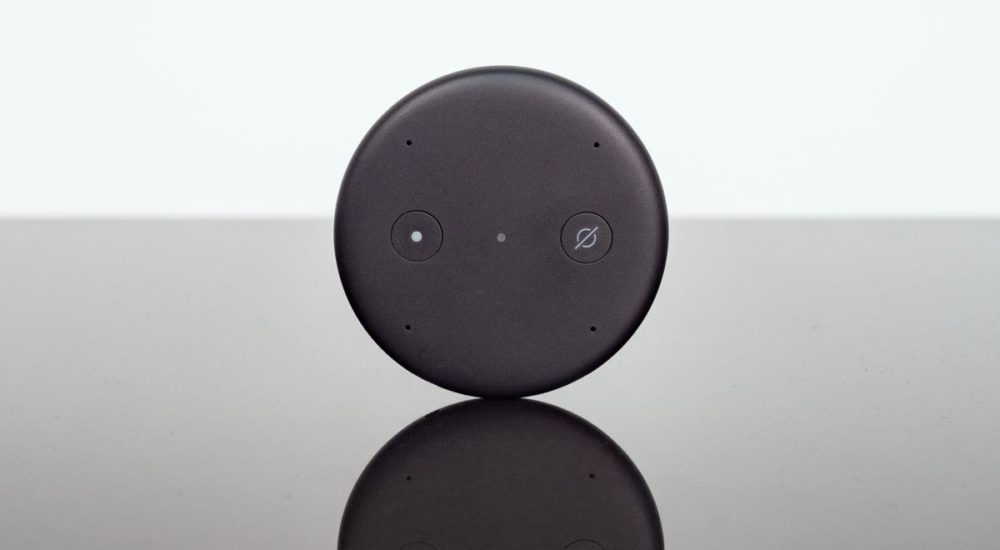The Echo Input is cheap and effective; perfect for reviving any old, non-smart speakers with a Bluetooth or 3.5mm analogue input
Pros
- Cheap
- Easy to use
- Works with Bluetooth and analogue speakers
Cons
- No optical output
- Analogue audio quality is so so
Amazon’s ubiquitous Echo smart speakers have been with us for a few years now, and every year that goes by the range seems to grow exponentially. Until now, though, it has been missing one key element: a connector, like the Chromecast Audio, that can be used to turn any dumb speaker into a modern smart, connected audio device. Enter the Amazon Echo Input, a device that aims to fill the vacuum that Google’s discontinued dongle leaves in the market.
Amazon Echo Input: What you need to know
The Echo Input is a simple device and, if you have prior knowledge of Amazon’s Echo products, is pretty easy to summarise. It’s essentially the same as an Echo Dot, just without the speaker.
That’s the part you supply, by either connecting the Input to an existing speaker or music system via a 3.5mm analogue cable or via Bluetooth. There’s no optical output as with the Chromecast Audio, however, and note that Sonos speakers are not supported as yet.
After you’ve done this, the Input behaves exactly as every other Amazon Echo product does, allowing you to ask questions about the weather, sports results and trivia, control smart home devices, stream music and set timers, all with the power of your voice.

Amazon Echo Input review: Price and competition
As such, the Echo Input is now the cheapest way of getting in on the Alexa smart speaker scene. Its regular price is £35 (currently down to £20 due to a ridiculously good deal), which is £15 less than the £50 Echo Dot speaker.
There isn’t much in the way of direct competition at this price now that Google has stopped making the Chromecast Audio, but even if it had been still been on sale, the Echo Input wouldn’t be a direct rival anyway. Although the end result – making an existing speaker smart – is the same, the Echo Input adds microphone input for voice control. To achieve the same with the Chromecast Audio you’d have to add a Home Mini into the mix as well.
Amazon Echo Input review: Design, features and performance
When I say that using the Echo Input is just like using any other Echo speaker, I’m not kidding. In fact, the device itself looks as if someone took a scalpel to an Echo Dot, removing the top panel and discarding the rest.
The layout is precisely the same, with activation and microphone buttons flanking a central status LED. The four microphones are arranged on the top surface in a square, forming a noise-cancelling, beamforming array which is able to pick out your voice from across a room, even above moderately loud music.
On the edge is a 3.5mm audio output jack and a micro-USB port for power. As mentioned above, there’s no optical output, though, which is a disappointment for anyone hoping to use the Input as a source for a more exotic, high-end system. That’s one area where the Chromecast audio was superior.

Setup is a breeze. Just as with an Echo Dot, you plug it in, wait for the central LED to turn orange and then use the Alexa App on your smartphone or tablet to add a new product, following the instructions onscreen to complete the installation.
And as for performance, that’s pretty good, too. I connected it directly to my active stereo studio monitor speakers, placing the Input on top of the right speaker and found the microphone array impressively sensitive. Even against a background of moderately loud music being played out of the speakers, it was able to pick up instructions and questions without having to raise my voice too loud or repeat myself.

Achieving Bluetooth connectivity to an existing Bluetooth speaker works nicely, too, and the Input will helpfully send you a notification via the smartphone app whenever it becomes disconnected from its partner device.
Sound quality is the one aspect of the Echo Input that I’m not so keen on. Admittedly, I’ve been comparing it to the iFi Nano and Chord Mojo, which are dedicated DACs that cost £200 and £400 respectively. But, there’s such a marked difference in depth, clarity and instrument separation that I don’t think I’d ever be happy leaving it connected to my big speakers.
It’s better via Bluetooth where its own DAC and circuitry won’t have such a big effect. And this is where it’s best employed: reviving a high quality, but dumb, Bluetooth speaker that may be gathering dust somewhere at home. For the price of a bottle of gin, you could turn it into an Amazon Echo 2 killer, coupling top sound quality with all the smarts of Amazon’s digital voice assistant. The one disappointment here is that there’s no support for the more advanced codecs such as AptX, AptX HD or LDAC.
Amazon Echo Input review: Verdict
In some ways, these concerns don’t really matter, though. The Echo Input has been designed as a cheap way of adding voice control to an existing speaker, nothing more, nothing less. You can’t expect it to act as a source in an expensive audio setup and it’s only because the Chromecast Audio had digital optical output that I’m even making the comparison in this review.
The fact remains that the Echo Input does its main job very well indeed and, for that reason, I’m going to give the Amazon Echo Input the big thumbs up. It’s only £35 and works pretty much perfectly, allowing you to give dumb Bluetooth and analogue speakers a timely smart boost. If you have an old speaker gathering dust that you just can’t bear to part with, go out and buy one.
Source: expertreviews.co.uk




































